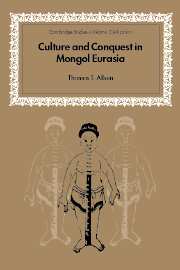Book contents
22 - Summation
Published online by Cambridge University Press: 04 September 2009
Summary
Inner Asia has long been seen as a zone of contact and transmission, a lengthy conveyor belt on which commercial and cultural wares traveled between the major civilizations of Eurasia. On the basis of the evidence presented here, the following conclusions seem warranted on the nomads' essential but largely unacknowledged role in this cultural traffic.
In the first place, the very act of creating a state in the steppe always stimulated the transcontinental circulation of prestige goods, especially textiles, because such luxuries were in fact necessities in the political culture of the Mongols and other nomads.
Second, while the state-bound culture of the empire had as its primary objective the control and exploitation of the Mongols' sedentary subjects, its secondary effect was the creation of numerous opportunities for cross-cultural contact, comparison, and exchange.
Third, the selection of the various components that entered into this syncretic state culture was determined by Mongolian cultural, social, and aesthetic norms as mediated, of course, by the conditions of conquest and pressing political interest.
Fourth, the Chinggisids viewed human talent and skill as a form of booty, to be “shared out” among the family just like land, herd animals, and material goods. The various Chinggisid branches, dispersed throughout Eurasia, competed for these specialists who were vital to their efforts to tap into the economic and cultural wealth of the settled zones of the empire.
- Type
- Chapter
- Information
- Culture and Conquest in Mongol Eurasia , pp. 210 - 211Publisher: Cambridge University PressPrint publication year: 2001



